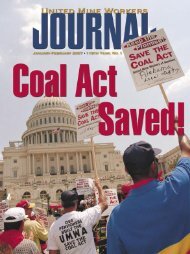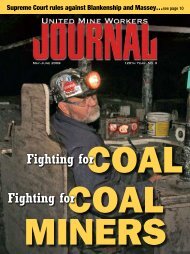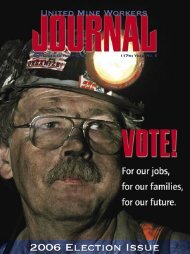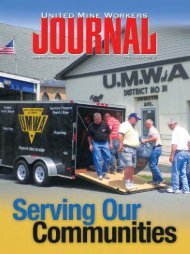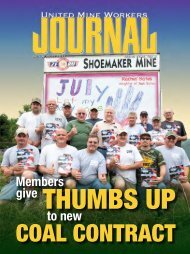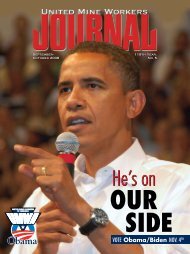March - April - United Mine Workers of America
March - April - United Mine Workers of America
March - April - United Mine Workers of America
- No tags were found...
You also want an ePaper? Increase the reach of your titles
YUMPU automatically turns print PDFs into web optimized ePapers that Google loves.
Are miners sAfer?WhenPresidentBarackObama appointedHilda Solis to be theSecretary <strong>of</strong> Laborin the weeks after hisinauguration, <strong>America</strong>nworkers could have confidencethat for the first time in eight years,they had someone in the lead atthe Labor Department who was ontheir side. She grew up in a unionhousehold with both <strong>of</strong> her parentspaying union dues.A look at thestate <strong>of</strong>mine safetyand healthin 2011PhIl SMIThThen came the nomination inJuly 2009 <strong>of</strong> Joe Main to be AssistantSecretary <strong>of</strong> labor for <strong>Mine</strong> Safetyand health. A long-time UMWAhealth and safety leader who headedthe union’s Department <strong>of</strong> Occupationalhealth and Safety for over threedecades, Main brought unprecedentedknowledge <strong>of</strong> mining health and safetyissues from a miners’ perspective.“Joe is perhaps the most knowledgeableperson about mine safetyand health in the nation,” PresidentRoberts said at the time <strong>of</strong> Main’snomination. “his experience wasgained where it counts the most—fighting every day for over 30years on behalf <strong>of</strong> miners’ healthand safety.”It’s been just over two years sinceSolis took <strong>of</strong>fice and 17 months sinceMain was confirmed in his position inOctober 2009. It’s an appropriate timeto ask: Are miners safer than theywere on Jan. 19, 2009, the day beforethe Obama administration began?2010 A deAdly yeArOne measure <strong>of</strong> the effectiveness <strong>of</strong>the enforcement <strong>of</strong> mine safety andhealth laws by the <strong>Mine</strong> Safety andhealth Administration (MShA) isthe fatality statistics. “These are theone set <strong>of</strong> numbers the coal operatorscan’t hide,” President Roberts said.“They can’t figure out ways to getaround these numbers like they try todo with lost-time injury statistics.”In 2009, 18 people were killed atU.S. mines. It was the lowest number<strong>of</strong> annual fatalities on record. One <strong>of</strong>those was a UMWA member workingat the Jim Walters #7 mine in Alabama.2010, however, was a completelydifferent story. There were 48 fatalitieslast year, the most in any year since1992. One <strong>of</strong> those miners was aUMWA member working at theloveridge mine in West Virginia. 2010also saw the worst mining disaster in40 years when 29 miners were killedat the Upper Big Branch mine inMontcoal, W.Va.“Any time miners are dying,something is wrong,” Roberts said. “AtUpper Big Branch, it’s very clear thatthe operator wasn’t doing its job tokeep miners safe on many differentlevels. What’s not so clear yet is howthis mine got to the point where adisaster <strong>of</strong> this magnitude could occur.”Along with MShA and the state<strong>of</strong> West Virginia, the UMWA isparticipating in the investigation atUpper Big Branch and will be writingits own, independent report about thedisaster. “We will take a hard look atwho was responsible for what at thatmine and let the chips fall where theymay,” Secretary-Treasurer Kane said.Despite calls from the UMWA andthe media to open up the process anddo a public investigation <strong>of</strong> the UpperBig Branch tragedy, the agency has keptit closed, citing a criminal investigationthat is being conducted by the JusticeDepartment into the disaster.It’s worth noting that thegovernment’s investigation into the10 <strong>March</strong>/<strong>April</strong> 2011 • <strong>United</strong> <strong>Mine</strong> <strong>Workers</strong> Journal



